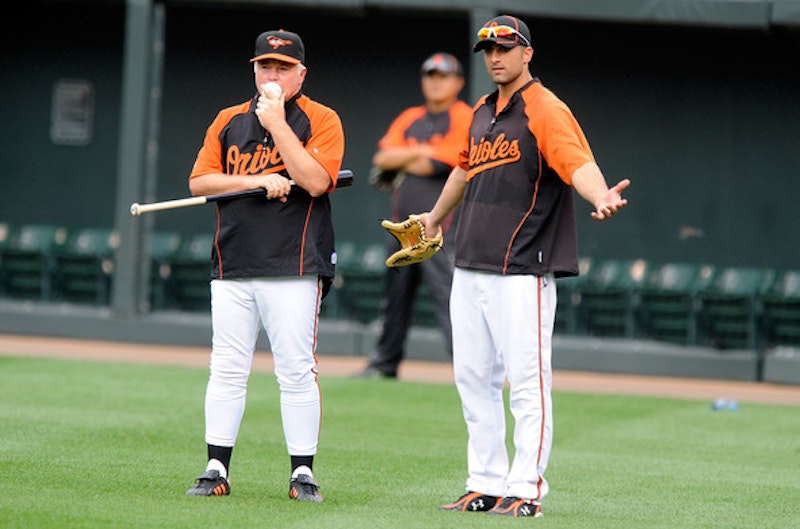The Baltimore Orioles are more than 20 games behind the first place Red Sox in the American League East and nearly as many back for the Wild Card. If O’s manager Buck Showalter was going to lead an insurrection to the top of the division it’ll have to be some other year. That doesn’t mean this won’t be an important year for the Orioles as a franchise. Championships aren’t just won the season they play out on the field. World Series trophies are years in the making. In an odd way the Orioles are in a good position. There is no ambiguity as to which direction the franchise should go. It’s teardown time.
What follows is one analyst’s three-step prescription for moving the franchise forward.
1. Stop handing out long-term, big money deals.
The Orioles traded minor leaguers Brett Jacobson and Jim Hoey to get J.J. Hardy from the Twins this past off-season. Hardy rewarded them by being the team’s third most valuable position player behind Matt Wieters and Adam Jones. That’s quite a haul for two minor leaguers with limited upside. But the trick for a team like Baltimore is to always be trading up. Take a 13th rounder in Hoey, develop him and then deal him for Hardy, who has a good year and increases his value. Then deal Hardy for a better minor league player or very young player who can be a part of the next good Orioles squad.
The Orioles chose instead to give Hardy a three-year contract extension. Hardy is having a good season but he’s 28 years old and at his peak right now. The trick to a good team is getting a lot of good players to peak simultaneously. Instead Hardy is peaking now and the Orioles are out of the race.
Once, when a star player asked him for a raise, Branch Rickey said, “We finished last with ya, we can finish last with out ya.” The Orioles are last with Hardy having his best season ever. Further, look at the shortstops on the trade market. If you believe that, as the Mets say, Jose Reyes is not going to be dealt, then Hardy becomes the best shortstop on the market. That’s a position of strength, one that a good General Manager can use to acquire good young talent for the future. Think the San Francisco Giants, who are flush with young pitching, wouldn’t deal for a shortstop who can hit? Hardy represents another lost opportunity for the O’s.
More generally, the team needs to figure out where their window of contention is and then work towards it. Signing young players to long-term team-friendly deals is one thing, but signing decent older players who won’t be productive when the team turns around is just setting back the timetable.
2. Trade anything not nailed down and over the age of 26.
Position players peak at around age 28. There are exceptions, of course, and the better players tend to have longer peaks, but we’re talking about the entire MLB population. With that in mind, everyone who won’t be a part of the next good Orioles team needs to be dealt for players who could be. Trading them may not net a future All-Star, but keep in mind when a team gets league average production at one position from a player at pre-arbitration prices, that frees up capital to be spent on bigger free agents.
For example, the Yankees are getting great production out of Brett Gardner even though his salary is just $500,000 this season. This lets them spend more on… well, everyone else on their roster. OK, bad example. But you get the point The Orioles should focus on accumulating as much young talent as they can possibly horde. Don’t worry about positions, they can always make more deals later. Koji Uehara and Jeremy Guthrie are the most talked about but not the only names. If the Orioles can get something for Derrek Lee they should. If another team will give up something for Luke Scott or Vlad Guerrero—even though both are still hurt—they should. I’d advocate putting Nick Markakis’ name out there to see what he could return. Trading Markakis could be selling low on a talented player, but if the Orioles can get out from under the $44 million owed him over the next three plus seasons, they might be better off spending that money elsewhere. It depends on when the team thinks it can compete.
3. Let the young guys play.
Finally, deals or not, let the young players play. We know what Lee and Guerrero can do, but with the year lost it’s time to learn about the young players the Orioles have on hand. This applies in spades to the young pitchers. This is a bad Orioles team. They aren’t going to have a winning record or anywhere close to it. But the remaining games can be an incredibly valuable on-the-job learning experience for the team’s young pitchers.
The next great Orioles team is out there. A serious rebuilding effort may as well start now instead of later.

